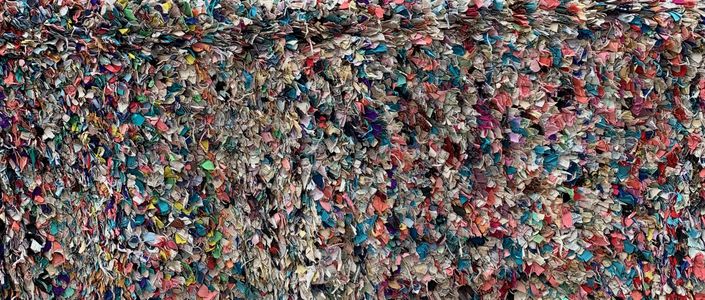
mossfelt
an ode to wool, that most magical of fibres, and a new technique for making soft scrumptious surfaces by combining worn textiles and wool felt
Enroll in Course

I fell in love with boucharouite rugs (the remarkable rag-rugs of Morocco) on my first visit there in 2019 and began experimenting with the technique as soon as I returned home.
Weaving big rugs requires a big upright loom so I began to experiment with ways to create large pieces from smaller sections woven on a "lap-loom". One day it came to me that I could combine felt-making and the layered stitched felting technique I call shibusa-felt to create a dense textured surface reminiscent of those delicious rugs I had encountered in Morocco.
The technique that I now call mossfelt, means that large carpets can be created in manageable sections that can be accommodated easily on your studio table (or better still, in your lap while sailing your armchair) and stitched together (like a patchwork) before the final felting.
It's a satisfying means of using up even the tiniest fabric scrap and the brilliant thing is that even the wildest colour combinations seem to work happily together. The surface can be formed randomly or with a pattern in mind and the process of stitching is calming and meditative.
You don't need to be an experienced weaver or felt maker or stitcher.
There's no complicated warping of looms required. No bamboo felting mats either.
All you need is scrap cloth, wool and thread.
It's a marvellous way of transforming old clothing that's beyond mending and not quite sturdy enough to twine into string or stitch into patchwork.
If you can cut cloth and do running stitch, you're already ahead.
The course explains clearly.how to set up your wool and cloth sandwich, explores several ways of stitching the rags to the surface and shows you how simply your piece can be felted once the stitching is done.

Even undyed scraps look beautiful when transformed into ragmoss....and can always be coloured later!

When I first taught the technique (to a group of travellers on my second visit to Morocco) I was calling it Boucharouite felt...but I felt (no pun intended) increasingly uncomfortable, appropriating the name of this beautiful style of woven rag rug from its rightful owners, the Amazigh women of Morocco. While the name literally translates to mean “the one made of a piece of cloth,” boucharouite is made from hundreds of cloth scraps, using both flat-weave and knotting techniques.
It wasn't until I had videoed the first half-dozen segments for this course that I came up with a more appropriate appellation, so you'll notice me still referring to boucharouite in the first few videos. I thought about dubbing voice-overs to change it, but felt that the presentation would become stilted and lose a bit of its life if I proceeded. So I've left it in place, and trust I'll be forgiven.
your guide

Frequently Asked Questions
The making of mossfelt is a slow-stitch practice, but a brilliant means of using up those fragments of cloth that are too narrow for patchwork and too short for making string. A comforting thing to keep in a basket by the armchair and pick up when taking a break from the rest of the world...though be warned, like knitting, once you get a feel for it, it may begin to murmur "just another row"...
I've created two enrolment possibilities, one in USD for those of you who prefer to use PayPal, and one in AUD because that is the currency where I live. Both of these are half-price until July 17th ... no need for a coupon !!
